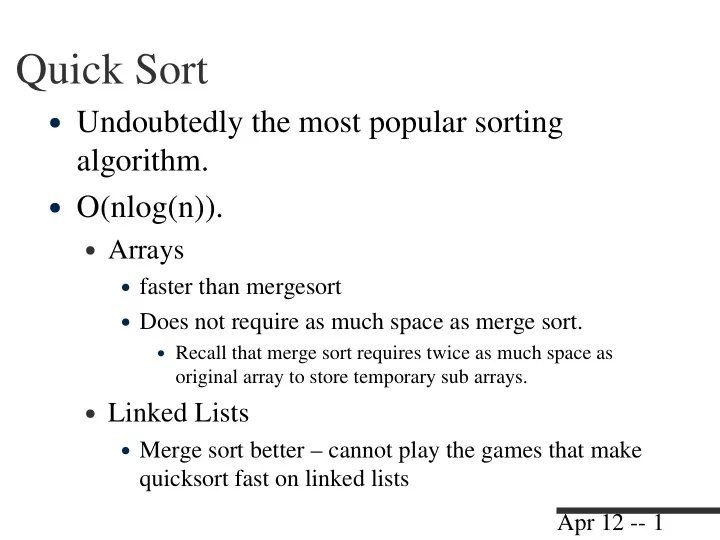

Quick Sort ● Undoubtedly the most popular sorting algorithm. ● O(nlog(n)). ● Arrays ● faster than mergesort ● Does not require as much space as merge sort. ● Recall that merge sort requires twice as much space as original array to store temporary sub arrays. ● Linked Lists ● Merge sort better – cannot play the games that make quicksort fast on linked lists Apr 12 -- 1
Partitioning ● Divide data into two groups, such that all items with a key value higher than a specified amount will be in one group, and the ones with lower key value in the other. ● Important: the items in each group are NOT sorted. ● The threshold value used to determine which group an item belongs is called the “pivot value”. Apr 12 -- 2
Partitioning Algorithm ● Starts with two indices, l and r , each will be moving towards each other. ● Advance the left index through the array until the first element larger than the pivot is encountered. ● Similarly advance the right index until the first element smaller than pivot is found. ● Swap the elements pointed to by left and right indices – thus they end up on the right side. ● Stop when two indices meet or cross each other. Apr 12 -- 3
Example ● If array looks like this: 12, 2, 5, 89, 0, 7, 19, 25, 67, 49, 88, 59 l r ● Partition with pivot value 50: 12, 2, 5, 89, 0, 7, 19, 25, 67, 49, 88, 59 l R ● First swap (89, 49) 12, 2, 5, 49, 0, 7, 19, 25, 67, 89, 88, 59 R l Apr 12 -- 4
Partitioning mid = (l+r)/2; pivot = theArray[mid]; while( l <= hi ) { while((l<hi0) && (theArray[l]<pivot)) l++; while((r>lo0)&& (theArray[r]>pivot)) r--; if( l <= r ) { swap(l, r); l++; r--; } } Apr 12 -- 5
Quicksort ● Partition the array into two subarrays according to some pivot value. ● Call itself recursively on each subarray. ● Somewhat like merge sort, except that there is no merge, as partitioning guarantees that left side is smaller than right side. Apr 12 -- 6
recQsort public void sort(int left, int right) { if (right-left<=0) //size 1, already sorted return; //partition sort(l, mid-1); sort(mid+1, r); } Apr 12 -- 7
How to Choose a Pivot? ● The pivot should be the key value of an actual data item. ● The choice can be more or less random. ● Let us always pick the last element. ● After partition, if the pivot is inserted between left and right partitions, it will be at its correct location. ● Bad pivot choice can result in O(n 2 ) time Apr 12 -- 8
Putting it together ● Make partition a method ● problem partition returns two values ● new lo and new hi ● Create a class tht holds these values ● only needed inside the QuickSort class ● Java allows such things ● public class QuickSort { private class Parter { ● the private class exists ONLY within the public class Apr 12 -- 9
Stable and Unstable Sorting ● Stable ● elements with equal keys retain order ● Unstable ● order of elements with equal keys is arbitrary ● When do you care? ● Insterion, Selection, Bubble, Merge, Quick ● which are they? Apr 12 -- 10
Quicksort example applets ● http://java.sun.com/applets/jdk/1.0/demo/Sor tDemo/example1.html ● http://mainline.brynmawr.edu/Courses/cs206 /fall2004/WorkshopApplets/Chap07/QuickS ort1/QuickSort1.html Apr 12 -- 11
Recommend
More recommend